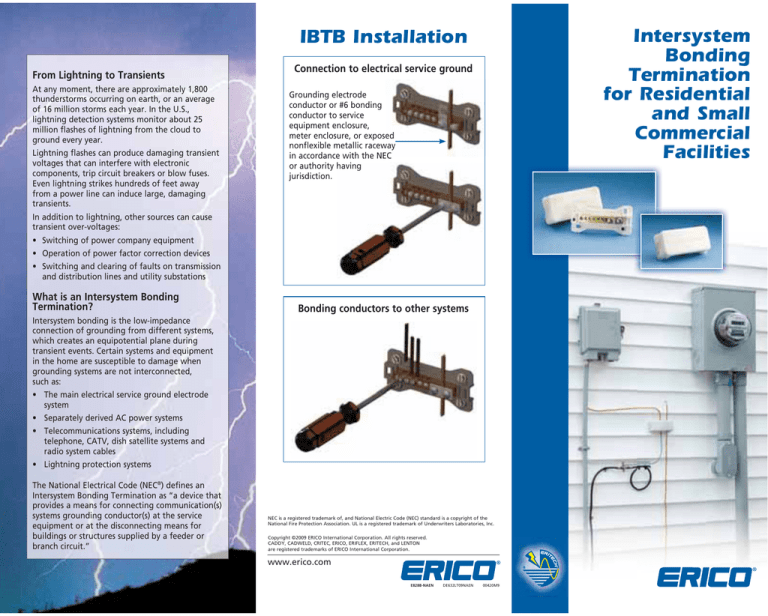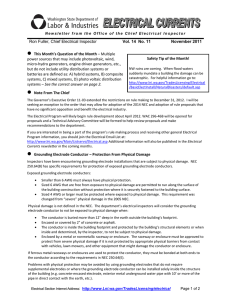
Intersystem
Bonding
Termination
for Residential
and Small
Commercial
Facilities
IBTB Installation
From Lightning to Transients
At any moment, there are approximately 1,800
thunderstorms occurring on earth, or an average
of 16 million storms each year. In the U.S.,
lightning detection systems monitor about 25
million flashes of lightning from the cloud to
ground every year.
Lightning flashes can produce damaging transient
voltages that can interfere with electronic
components, trip circuit breakers or blow fuses.
Even lightning strikes hundreds of feet away
from a power line can induce large, damaging
transients.
In addition to lightning, other sources can cause
transient over-voltages:
• Switching of power company equipment
• Operation of power factor correction devices
• Switching and clearing of faults on transmission
and distribution lines and utility substations
What is an Intersystem Bonding
Termination?
Connection to electrical service ground
Grounding electrode
conductor or #6 bonding
conductor to service
equipment enclosure,
meter enclosure, or exposed
nonflexible metallic raceway
in accordance with the NEC
or authority having
jurisdiction.
Bonding conductors to other systems
Intersystem bonding is the low-impedance
connection of grounding from different systems,
which creates an equipotential plane during
transient events. Certain systems and equipment
in the home are susceptible to damage when
grounding systems are not interconnected,
such as:
• The main electrical service ground electrode
system
• Separately derived AC power systems
• Telecommunications systems, including
telephone, CATV, dish satellite systems and
radio system cables
• Lightning protection systems
The National Electrical Code (NEC®) defines an
Intersystem Bonding Termination as “a device that
provides a means for connecting communication(s)
systems grounding conductor(s) at the service
equipment or at the disconnecting means for
buildings or structures supplied by a feeder or
branch circuit.”
NEC is a registered trademark of, and National Electric Code (NEC) standard is a copyright of the
National Fire Protection Association. UL is a registered trademark of Underwriters Laboratories, Inc.
Copyright ©2009 ERICO International Corporation. All rights reserved.
CADDY, CADWELD, CRITEC, ERICO, ERIFLEX, ERITECH, and LENTON
are registered trademarks of ERICO International Corporation.
www.erico.com
E828B-NAEN
DE632LT09NAEN
00420M9
NEC Requirements:
Intersystem Bonding Termination (IBTB)
Installation of the IBTB
The 2008 edition of the NEC requires the
installation of an intersystem bonding termination
at the electrical source for all new construction.
Per the NEC, there are three acceptable methods
to bond systems in a building:
Designed to meet the requirements of NEC Article 250.94
“Bonding for Other Systems,” the Intersystem Bonding
Termination, part of the ERITECH® line of products from
ERICO®, is an easy-to-install way to interconnect and
terminate grounding conductors from power service,
telephone, CATV or radio and television antennas.
The IBTB should be installed in close proximity
to the electrical and communications service
entrances. The top clamp of the IBTB was
designed to accommodate the main grounding
electrode conductor as a through-feed. This
allows the conductor to be installed in one
continuous length in accordance with NEC
requirements. If this is not feasible, a bonding
conductor from the main ground electrode
conductor can be installed to the IBTB.
1. A set of terminals securely mounted to the
meter enclosure and electrically connected to
the meter enclosure. The terminals shall be
listed as grounding and bonding equipment.
2. A bonding bar near the service equipment
enclosure, meter enclosure or raceway for
service conductors. The bonding bar shall be
connected with a minimum 6 AWG copper
conductor to an equipment grounding
conductor(s) in the service equipment
enclosure, meter enclosure or exposed
nonflexible metallic raceway.
3. A bonding bar near the grounding electrode
conductor. The bonding bar shall be connected
to the grounding electrode conductor with a
minimum 6 AWG copper conductor.
The IBTB is mounted adjacent to the meter base or
service entrance equipment. It includes corrosion-resistant,
stainless steel mounting hardware and is easily accessible
for connection and inspection. The lay-in connection
clamp (#6 AWG – #2 AWG) allows easy installation of the
grounding electrode conductor in one continuous length,
where possible. The IBTB also features a polymeric base
and housing, which is impact-resistant, UV-stabilized and
meets UL® requirements for weatherability performance.
IBTB features:
• Ideal for residential and small commercial facilities
• Accommodates (5) 14 - 4 AWG bonding conductors
and (1) 6 – 2 AWG grounding electrode conductor
• UL Listed as an intersystem bonding termination
All of the required mounting hardware and
anchors are included to install the IBTB.
It is ideal for CATV, telephone, satellite or
structural lightning protection systems to make
a convenient and easy bonding location for
optimal intersystem bonding performance.
The IBTB is available at electrical distributors
throughout the U.S. Contact your local ERICO
representative for more information or visit
www.erico.com.
• Integral mounting base enables easy installation
• Includes mounting hardware
• Connections to grounding electrode conductor —
does not rely on meter base enclosure bonding
connection
• Meets the requirements of 2008 NEC Article 250.94
Part No.
IBTB
Weight (lbs)
0.3
Depth (in)
1.41
Width (in)
2.01
Length (in)
4
Conductor Size Range
14 AWG – 2 AWG



